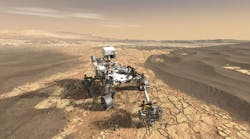On July 30, 2020, NASA’s Mars Exploration Program sent its Perseverance Rover on its way for a Martian touchdown on February 18, 2021. Missions like these require the utmost in environmental ruggedness from all of the constituent elements of the system. One of those elements, a high-performance, ruggedized 2-mm CompactPCI (cPCI) connector from Smiths Interconnect, will be onboard the Perseverence Rover, the most sophisticated rover yet to emerge from NASA’s labs.
The 2-mm connector provides the rover with a high-reliability connector that meets the stringent mechanical, electrical, and environmental performance requirements. The interconnect underwent rigorous testing for extreme environmental conditions, including thermal excursions, corrosive atmospheres, excessive shock and vibration, contact engagement/separation cycling, and other key NASA requirements at its Jet Propulsion Laboratory in Pasadena, CA.
The cPCI 2-mm connectors are based on Smiths Interconnect’s Hypertac hyperboloid contact technology, known for its immunity to shock, vibration, and fretting. Tested to high-level space and aerospace standards, the series delivers high performance in mission-critical applications such as military land systems, shipboard, spacecraft, and defense applications.
The cPCI series is qualified to NASA GSFC: S-311-P-822 and assigned NASA Goddard part numbers. It provides:
· High-speed signal integrity up to 3.125 Gb/s
· High-temp LCP insulators that meet NASA outgassing requirements
· Keying features to ensure proper mating
· An integrated shield to maximize EMI/RFI leakage
· Compatibility with reflow soldering processes
· Low insertion and extraction forces for reduced board strain and improved serviceability
Designed to be the most sophisticated rover NASA has built, the Mars Perseverance Rover will use advanced systems to explore the diverse geological landscape, discover ancient habitats, gather rock and soil samples that will be returned to Earth and demonstrate cutting-edge technology for future human exploration.
The vehicle is loaded with state-of-the-art scientific instruments, advanced computational capabilities for landing, upgraded sensors, computers and algorithms. It will enable the rover to realize its Martian location quickly and autonomously and modify its course during descent. This technology will be able to provide invaluable assistance for both robotic and crewed missions landing on extraterrestrial planets and a must for future robotics and missions to Mars.
Smiths Interconnect, www.smithsinterconnect.com

